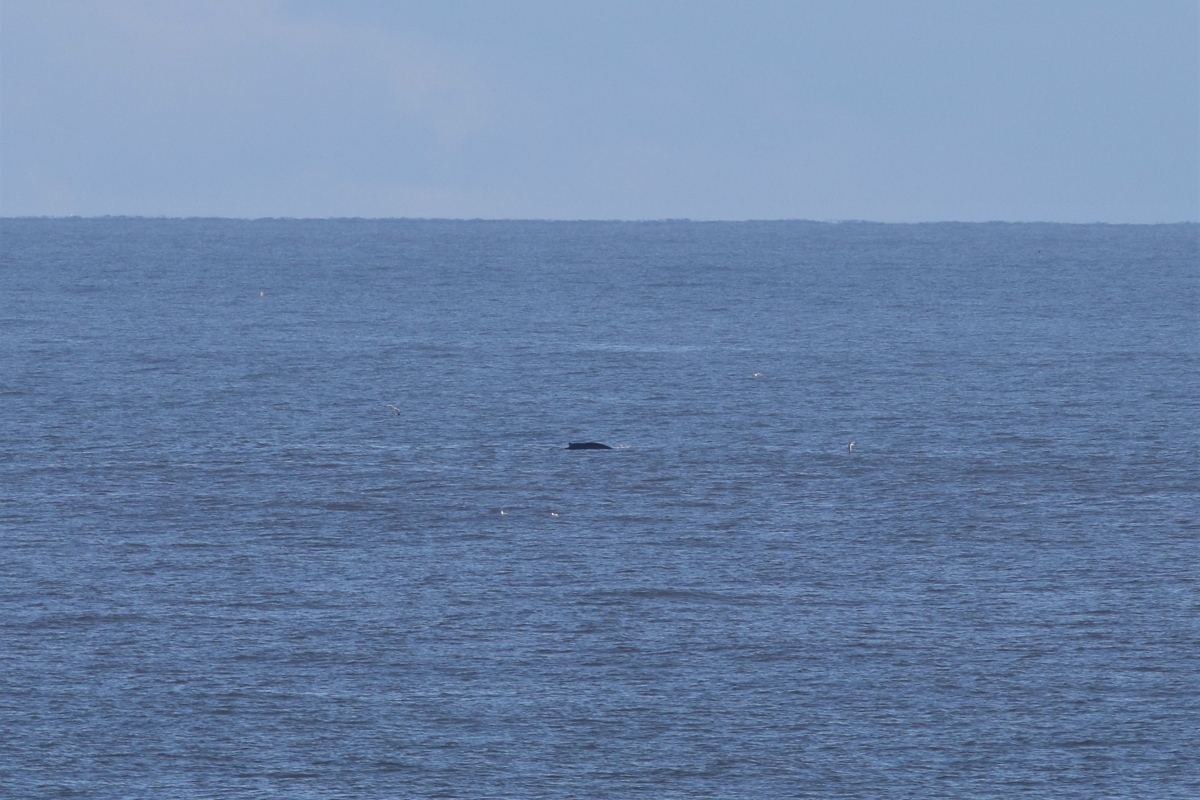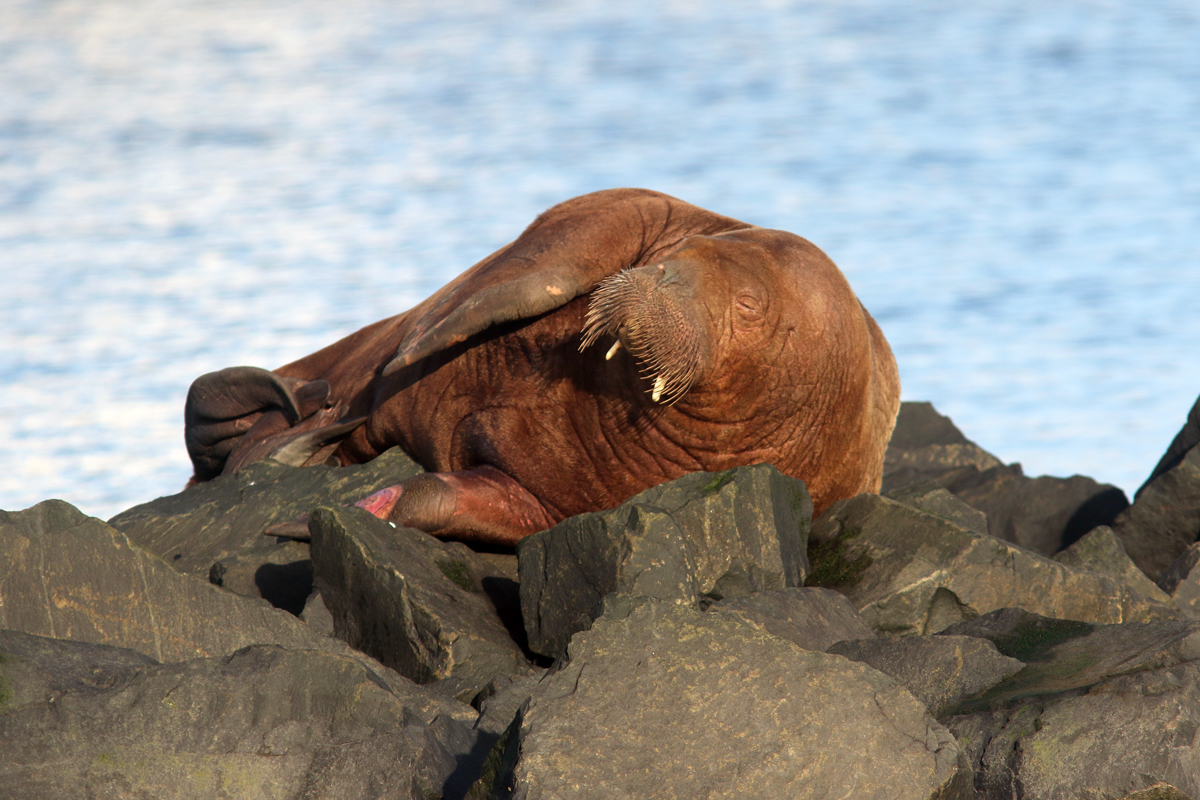Whilst this year was not the same vintage as 2020, Northumberland still managed to pull some good birds out of the bag. Our county seems to be getting a lot better at this in recent years. Maybe we have more observer coverage these days?
January -
We began the year in full lockdown mode. Well, some of us did.
There was only one outright winner in the opening month of the year and that was significantly bigger than any bird. On 31st our neighbour Mandy found a showy Humpback Whale just off the Bathing House. 'Ive only seen one Minke here before so this had us speed walking along the road to check it out. Unfortunately as with most of these poor animals in the North Sea, it was finally found moribund, entangled in lobster pot ropes.
The wintering Hooded Crow became a garden favourite eating most forms of meal left overs first thing in the mornings.

|
| Humpback Whale |
February -
A cold stormy spell at the beginning of the month left us with some good garden bird activity but a day without electric. De-ja-vu. Barn Owl, Woodcock, 2 Kestrels and Hooded Crow plus a load of Fieldfares all feeding in our garden.
On 21st a Water Rail took up residence in our tiny village pond until spring though it remained very elusive throughout its stay.
The Humpback Whale remained during the month. A county first was found near the end of the month with a one day wonder drake Bufflehead at Cresswell. I could have gone but decided to stick with the lockdown rules on essential travel and didn't bother. If it had remained another day I don't think my resolve would have held out.
March -
Hoodie still around and Barn Owls every day from the house. We finally got out and about mid month. On the 14th an adult Mediterranean Gull was over our house. On the 18th the only patch Red legged Partridge of the year was calling on top of the Hips Heugh, scoped from our garden and on the same date, a new invert for me, were 25+ Water Crickets in a ditch in the village wood. Spring seemed to be here on 22nd with a Hairy footed Flower Bee on flowering currant in the garden.
Some garden safari mayhem occurred on 27th when my first ever Weasel in the garden caught a Jackdaw below the feeders. The Jack eventually flew off carrying the unlucky mustelid!
April -
We received our first vaccinations against Covid on 3rd. A cold but sunny day, the garden was alive with 5 species of Bumblebee. Spring migrants much in evidence with Wheatear, Sand Martin, Blackcap and Sandwich Tern around. The first village Swallows were back on the 10th but on 11th we had a covering of snow. Very strange seeing a Swallow flying over a white dusted landscape.
An Osprey narrowly missed slipping through Alnmouth unnoticed on 11th.
A few new inverts during these early spring days, 2 Hoverflies and a mining bee, Criorhina ranunculi and Eristalis intricaria plus Andrena nigroeana. See blog pages for details.
A morning inland west of Alnwick on 18th was nice with a good party of 6 Ring Ouzels the largest group Ive seen locally, Redstart and Willow Warbler.
On 23rd my first rarity of the year, a lifer, came when Gary Woodburn found a Red throated Pipit on Embleton Golf Course. A very nice bird too.
May -
The month began up on the moors with Green Hairstreaks and Emperor Moths, a Redstarts nest, Tree Pipit, Cuckoo and Whimbrel.
Things certainly took an upturn on 6th when the Northern Mockingbird from Devon relocated to a Newbiggin garden for a few days. What a totally unpredictable occurrence. Fabulous though.
The best at Boulmer were Little Terns and a very imposing Bonxie sitting around on the beach as tourists walked by. It even gave a small Daschund the eye at one point.

|
| Northern Mockingbird |
June -
Another 'biggie' was worthy of a twitch down to Blyth on 5th for mine and Northumberland's second Red necked Stint, and what a cracker it was too. A Great Reed Warbler was singing and showing at East Chevington on the same day made for a good morning out.
Less than a week later, on the 10th, another county first showed up, this time a British tick for me too. A Pacific Swift showed brilliantly, again, at East Chev where it strafed past us at ranges down to 10 mtrs.
Some local inland Nightjars gave the best ever views near the month end.

|
July -
Came in like the proverbial Lion on the first when a reported Fea's Petrel flew North at Flamborough early morning. As I'd only ever seen one, we staked it out at Cullernose where it came close past at 6.15pm giving great views. Later on the socials, Paul French of the BBRC commented that 'Did it really have a breast band? After seeing photos posted by two observers from Newbiggin. It surely did, making it actually a first for Britain, a Soft Plumaged Petrel Pterodroma mollis. Amazing.
The 10th was my worst birding day of the year when we spent 11 hours at Bempton dipping the Albatross. Subsequent analysis of its presence showed that it eventually was present for 90 days but on 30 of those days it was not seen from the cliffs. Only a 66% chance of success then. Better luck in 2022.
Another bit of dippage occurred on 20th when the long staying Black Tern up at the Long Nanny at Low Newton was reidentified as an American Black Tern. I went up for a look but it had already gone for the autumn. Again it may come back next year?
On 24th a lovely Water Shrew showed very well scrummaging around our drive for 10 minutes before vanishing into a neighbours old greenhouse.
August -
Some August staples began to appear on patch with Sooty Shearwaters, Roseate Terns and returning waders.Best of these was my first patch Spotted Redshank at Seaton Point, a rare bird in this fresh water scrape devoid area.
The best of the month though was a flock of 5 Black tailed Godwits N past our garden on 24th. A rare patch bird at the best of times but from the garden, get in.
August ended with a second year Long tailed Skua on the sea with an Arctic Skua for comparison, at Boulmer.
September -
Seawatching proper commenced on the 1st with a very smart spooned up Pomarine Skua close north at Cullernose, making it a four skua year on patch.
On 3rd we went to Suffolk for two weeks. Down here I get taken up with the multitude of new insects that can be found that we just dont get at home. A pristine Clifden Nonpareil and a Buttoned Snout both came to sugar, while Box Tree Moth was also new to me. At Carlton Marshes, a few Fen Raft Spiders Dolomedes plantarius showed well enough for photos with a supporting cast of Chinese Water Deer, Wasp Spider and Brown Hawker.
On the day I returned, the 19th, my tardiness ensured I dipped out on a patch Semi palmated Sandpiper by 5 minutes. Its getting to be a theme this year.
On the 29th, another new spider, but more local near our village was found - Invisible Spider Drapestica socialis.

|
| Clifden Nonpariel |
October -
A Norwegian colour ringed Bar tailed Godwit was at Boulmer but on the 9th it was good to get a huge county grip back. A visitor found Northumberland's 3rd Red eyed Vireo on the Straight Lonnen, Holy Island. Unlike the last two flitters, this one stayed for a week where despite being in thick cover with some patience decent views could be achieved.
Around this time some garden moth migration began to take place. A very unusual phenomena here. Gem, Rush Veneer, Dark Swordgrass, Silver Y and Diamond backs were all found but even better was a Delicate caught by Mandy at Seahouses Farm and on 11th I caught the North of England's first Radford's Flame Shoulder. The furthest north in the UK by about 200 miles!
Still the wind remained stubbornly in the west with a distinct lack of migration on the coast. My first year for a while with no sightings of Yellow browed Warbler.

|
| Radford's Flame Shoulder |
November -
A nice Wilson's Phalarope saw in the month on a small farm pond at Newstead. A county tick for a few, this was my third in Northumberland.
One of the absolute wildlife highlights of the year must be the female Walrus that graced Seahouses Harbour on 14th. A appreciative pilgrimage continued all day but she was not seen in the morning. Freya has subsequently been relocated in December in Shetland on her way back North.
A not so welcome visitor, Storm Arwen arrived on the 26th and knocked us back into the stone age for a fortnight. Still, it did give some great late season seawatching with Great Shearwater, 2 Black Guillemots, Little Auk, Great Northern and Black throated Divers, Red necked Grebe, Glaucous Gull and Velvet Scoters.
 |
| Freya the Walrus |
December -
After 10 days without power, probably the most significant event, personally, this year we were back in the land of the living on 6th December only to find Storm Barra banging on the windows on the 7th. Fortunately it did not have the impact of his older sister.
The month did not really produce a lot locally other than a Lapland Bunting south on 16th. A Surf Scoter passed Whitburn and St Mary's on the solstice but bailed out before getting near the home patch. While I waited, a Great Northern Diver and a Woodcock were some compensation.
The year ended where it began, facing further Covid restrictions in the wave of new strain Omicron. In such uncertain times, who knows what 2022 will bring so there will not be any predictions from me other than to hope the Bempton Albatross liked it so much it decides on a return summer visit.
Stay safe everyone, thank you for all of your engagements on here, emails and tweets, its much appreciated.
Happy New Year!





5 comments:
Sensational account and artwork of an enviable year's birding! I absolutely LOVE your paintings!
Happy New Year. A great round up with the usual amazing visual accompaniments. Hope you have a nature filled 2022.
What a lovely blog with nature and drawings the same time.
A mouth-watering summary Stew, and as usual, terrific paintings. All the best for 2022. 😊 👍
Thank you all for the kind comments, have a great 2022!
Post a Comment